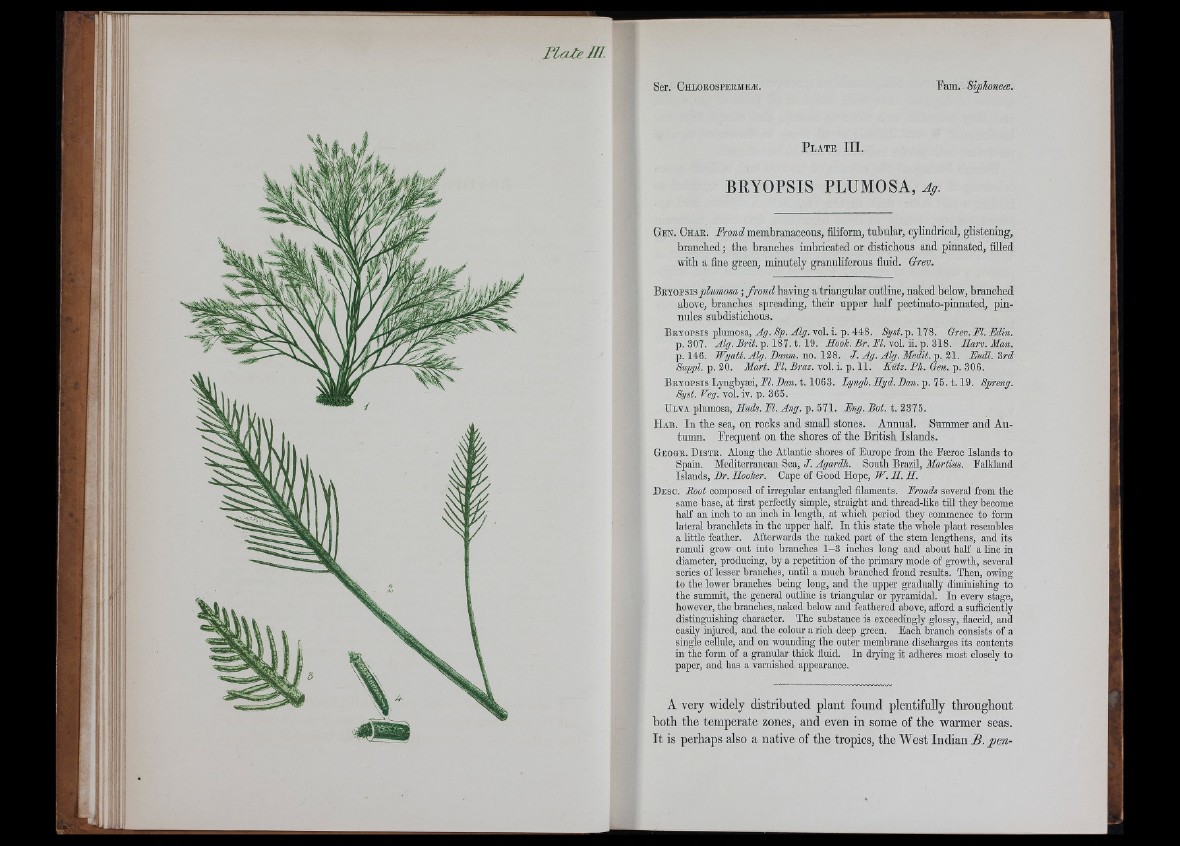
FlcUelfl.
( '
P l a t e III.
BRYOPSIS PLUMOSA,
Gen. Char. Frond membranaceous, filiform, tubular, cylindrical, glistening,
branched; the branches imbricated or distichous and pinnated, filled
with a fine green, minutely granuliferous fluid. Orev.
'Binciss.is,plumosa; fro n d having a triangular outline, naked below, branched
above, branches spreading, their upper half pectinato-pinnated, pinnules
subdistiohous.
Bryopsis plumosa, vol. i. p. 448. <Sys<. p. 178. Grev.M..
p. 307. A lg .B r i t .p .W l . t .W . Hook. Br. F l.y o l. i i . p . 313. Harv. Man.
p. 146. Wyatt. Alg. JDanm. no. 138. / . Ag. Alg. Medit. p. 31. Fhtdl. 3rd
Suppl. p. 20. Mart. Ft. Braz. vol. i. p. 11. Kiitz. Ph. Gen. p. 306.
B r y o p s is Lyngbysei, jK. Da». 1 .1063. l y n g h .H y d .B a n .p .^ ^ .i.V i. Spreng.
Syst. Veg. vol. iv. p. 365.
U lva plumosa, Huds. FI. Aug. p. 571. Fkg. Bot. t. 2375.
H ab. In the sea, on rocks and small stones. Annual. Summer and Autumn.
Frequent on the shores of the British Islands.
G e o g r . D i s t r . Along the Atlantic shores of Europe from the Faeroe Islands to
Spain. Mediterranean Sea, J. Agardh. South Brazil, Martins. Falkland
Islands, Dr. Hooker. Cape of Good Hope, W. H. H.
D e s c . Boot composed of irregular entangled filaments. Fronds several from the
same base, at first perfectly simple, straight and thread-hke till they become
half an inch to an inch in length, at which period they commence to form
lateral branohlets in the upper half. In this state the whole plant resembles
a little feather. Afterwards the naked part of the stem lengthens, and its
ramuh grow out into branches 1-3 inches long and about half a line in
diameter, producing, by a repetition of the primary mode of growth, several
series of lesser branches, until a much branched frond results. Then, owing
to the lower branches being long, and the upper gradually diminishing to
the summit, the general outline is triangular or pyramidal. In every stage,
however, the branches, naked below and feathered above, afford a sufficiently
distinguishing character. The substance is exceedingly glossy, flaccid, and
easily injured, and the colom- a rich deep green. Each branch consists of a
single cellule, and on wounding the outer membrane dischai-ges its contents
in the form of a granular thick fluid. In diying it adheres most closely to
paper, and has a varnished appearance.
A very widely distributed plant found plentifully tbrougliout
both the temperate zones, and even in some of the warmer seas.
It is perhaps also a native of the tropics, the West Indian B. pen